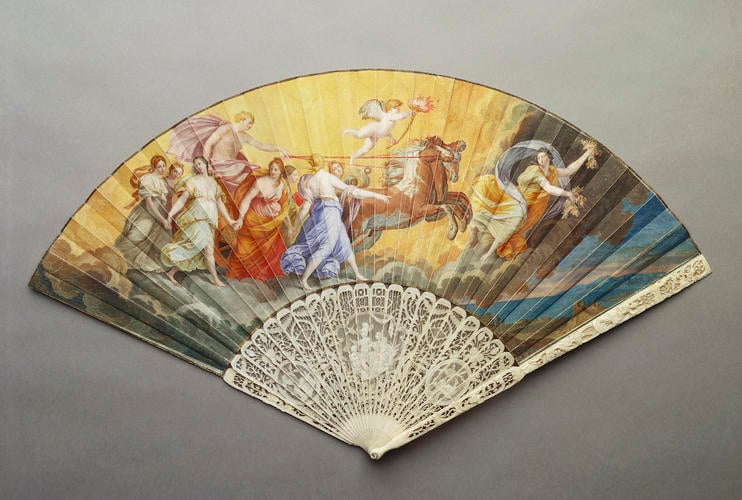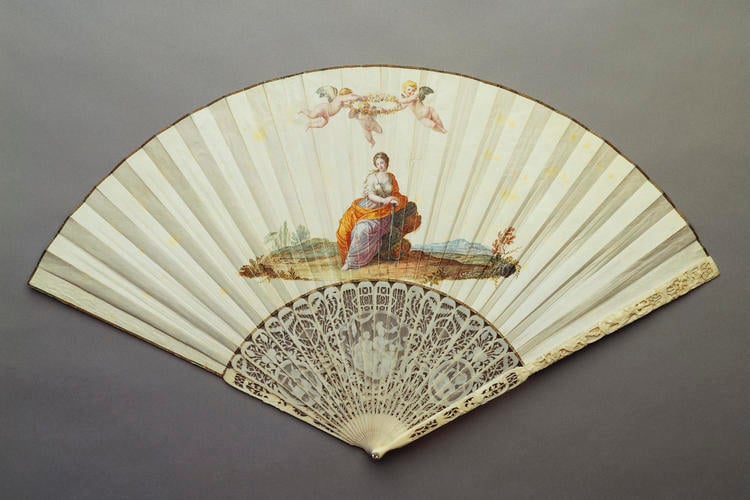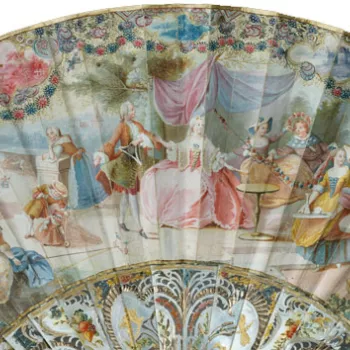Fan depicting 'Aurora and Apollo' c. 1780
Vellum leaf; carved and pierced ivory guards (identical) and sticks (2 + 20); silver pin with paste head | 29.9 cm (guardstick) | RCIN 25075
-
Aurora was the rosy-fingered goddess of the dawn. Each morning she would leave her aged husband in bed to lead her brother Helios, the sun-god, to the heavens. Aurora appears at right, her hands full of flowers that she will scatter over the earth. In the sky above the chariot of Helios is the amoretto Phosphorus, the morning star, who holds a lighted torch. The imagery is more overtly romantic in the ivory carving in the gorge, where Mars and Venus are shown. The foredge carving revealed when the fan is closed includes further romantic symbols.
The composition is based on Guido Reni's original (also known as The Triumph of Aurora, painted in 1615 in the Casino Rospigliosi, Rome, and subsequently widely publicised through painted and engraved copies. The Triumph of Aurora was considered to be Reni's masterpiece. The romantic subject-matter combined with the high standing occupied by the artist throughout the eighteenth century, and the ease of access (via engraved copies) to the composition, ensured that it was a very popular subject with fan-makers. Numerous other fan leaves decorated with this composition are known, but this is the only one that is signed. Giuseppe Trono (1739-1810) was the son of Alessandro Trono, a Piedmontese artist. He specialised in making miniature copies of paintings by Old Masters, particularly in Naples and Rome. In 1781 he was appointed painter and miniaturist to the royal court in Turin. Four years later he travelled to Lisbon, where he produced portraits and some religious works.
The fan was a gift to the young Queen Victoria from her Lady of the Bedchamber, the Duchess of Bedford. Queen Victoria believed that it had belonged to Queen Charlotte, and Queen Mary subsequently identified it as 'A fan with highly finished painting on ivory, from the Aurora of Guido, with pearl rivet', included in Queen Charlotte's 1819 sale catalogue. As the Duchess's gift was made only twenty years after that sale, the identification is likely to be correct, in spite of the curious description. The fan may possibly have been acquired in Italy by Queen Charlotte's sixth son, Augustus, later Duke of Sussex, who was in Rome in the early 1790s. The Queen's correspondence with Prince Augustus at this time includes a request for some Italian fan leather 'quite white for to paint on, and if besides you will send us some Naples fan mounts I shall be much obliged to you'. On their arrival in England, the fan mounts (i.e. leaves) would have been made up as fans, for the use of the royal ladies.
Vellum leaf, signed Trono F, bottom right
Text adapted from Unfolding Pictures: Fans in the Royal Collection, 2005Provenance
Reputedly, Queen Charlotte. Presented to Queen Victoria by Anna Maria, Duchess of Bedford when the Duchess was Lady of the Bedchamber, c. 1837-41
-
Creator(s)
(nationality)Acquirer(s)
-
Medium and techniques
Vellum leaf; carved and pierced ivory guards (identical) and sticks (2 + 20); silver pin with paste head
Measurements
29.9 cm (guardstick)
Category
Object type(s)











